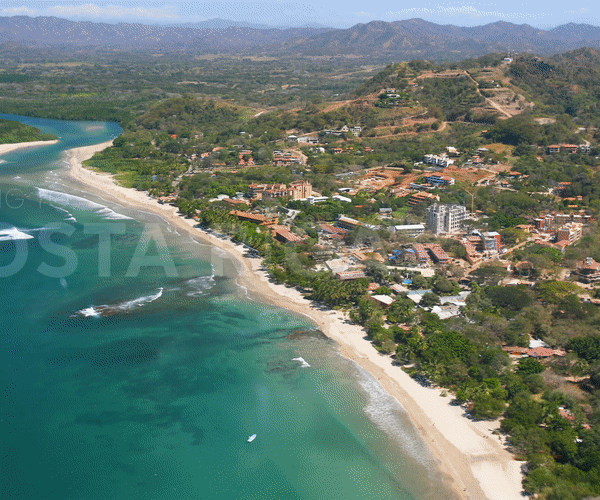COSTA RICA
LATEST ARTICLES
Costa Rica - A Recipe for Life
by Anna Bryony Graham in Costa Rica
Do you want to live to 100? Moving to Costa Rica might just up your chances! The Nicoya Peninsula, in the Province of Guanacaste, was designated a Blue Zone by a project that traveled the world to discover the secret to becoming a centenarian.
People live longer in Blue Zones, and remain healthier and happier than anywhere else on the planet, so what is their recipe for life?
Step One - surround yourself with people that make you feel good – spending time with friends and family will give you a strong sense of community, and purpose.
Step Two - stay active in your everyday life. That does not always mean ‘working out', as we westerners know it, but walking everywhere you can, and not only doing physical chores, like cleaning, and cooking but finding joy in them too!
Step Three – fuel your life with wholesome food. Ticos (the name for Costa Rican folk) eat a predominantly plant-based diet. Readily available fruit and vegetables, together with carbohydrates, yes, carbs, found in whole grains, such as corn, rice, and beans, and tubers, like sweet potato, are essential ingredients for life. Did you know corn and beans contain all nine essential amino acids? The same nine are also found in meat, fish, and eggs, but these also contain cholesterol and saturated fat. That is not to say these healthy centenarians never eat meat, just not as much.

Photo by www.bookmundi.com
Moving to a new country can mean leaving family and friends behind, but by staying in touch with those people, and making new ones in Costa Rica, you can end up with your very own extended Tico family! Check out this great article about how to make friends in Costa Rica: click here.
Costa Rica is also the perfect place to stay active. Whether you are strolling through a local market in search of fresh ingredients, walking through a rainforest in search of wildlife, or going for a daily swim in the ocean, there are plenty of ways to keep moving and enjoy life!
Western food culture has certainly made its mark in Costa Rica, and it is possible to eat dishes from all over the world, but if you want to eat like a Tico and more centenarian style, you can! Costa Rican cuisine is available in most restaurants, but if you want an authentic Tico experience, you should go to a Soda – no, nothing to do with Coca Cola, this is the name for local, family-run restaurants that make tasty, affordable Costa Rican food, most importantly, with a smile!

For a more modern dining experience in the heart of Nicoya, and inspired by its Blue Zone, try CanelAzul Café and Restaurant or for a traditional Tico breakfast, lunch, or dinner time, try Soda El Condor.
Eating out will certainly give you a taste of Costa Rica, but the only way to truly immerse yourself in the Tico culture, and to live like a centenarian, is to eat and drink like one en casa (at home)...
Wake up with a Costa Rican coffee. This daily ritual can be beneficial to your health; containing essential antioxidants, it can lift your mood, lower inflammation, lower your risk of type 2 diabetes, and even lower the risk of prostate cancer in men: click here to learn more.
Follow this link to find out about Blue Zone, sustainable coffee, grown in the volcanic soils of Nicoya’s highlands: click here.
Now you are awake, it is time to feast on fresh fruit. You will certainly come across more familiar tropical fruits such as mango, watermelon, pineapple, blackberry, papaya, star fruit, passion fruit, coconut, orange, and banana; a satisfying selection, but why not give lesser-known guanábana a go - a large spiny fruit with a tart pulp, or cas – a sour guava native to Central America. Depending on the fruit, tuck into it whole, break open and scoop out the flesh, or chop up and fill your plate!
You might have fruit trees and bushes already growing in your Costa Rican garden - if so pluck straight from the branch, if not, plant them! If you are in any doubt as to what the fruit is, do not eat it until you have found out it is safe. Buy trees at a local nursery, and always ask for advice about what would work best for your plot, and taste buds! If you do not have space, or while you wait for your trees to grow, buy fruit fresh, and organic if possible, from local vendors.
For a more modern dining experience in the heart of Nicoya, and inspired by its Blue Zone, try CanelAzul Café and Restaurant or for a traditional Tico breakfast, lunch, or dinner time, try Soda El Condor.
Eating out will certainly give you a taste of Costa Rica, but the only way to truly immerse yourself in the Tico culture, and to live like a centenarian, is to eat and drink like one en casa (at home)...Wake up with a Costa Rican coffee.
This daily ritual can be beneficial to your health; containing essential antioxidants, it can lift your mood, lower inflammation, lower your risk of type 2 diabetes, and even lower the risk of prostate cancer in men: click here to learn more.
Follow this link to find out about Blue Zone, sustainable coffee, grown in the volcanic soils of Nicoya’s highlands: click here.
Now you are awake, it is time to feast on fresh fruit. You will certainly come across more familiar tropical fruits such as mango, watermelon, pineapple, blackberry, papaya, star fruit, passion fruit, coconut, orange, and banana; a satisfying selection, but why not give lesser-known guanábana a go - a large spiny fruit with a tart pulp, or cas – a sour guava native to Central America. Depending on the fruit, tuck into it whole, break open and scoop out the flesh, or chop up and fill your plate!
You might have fruit trees and bushes already growing in your Costa Rican garden - if so pluck straight from the branch, if not, plant them! If you are in any doubt as to what the fruit is, do not eat it until you have found out it is safe. Buy trees at a local nursery, and always ask for advice about what would work best for your plot, and taste buds! If you do not have space, or while you wait for your trees to grow, buy fruit fresh, and organic if possible, from local vendors.

Photo by https://whereismyspoon.co/
Next on your menu is Costa Rica’s national dish, Gallo Pinto, pronounced GUY-YOH / PEEN-TOH, and meaning ‘spotted rooster’! Whether the name is attributed to its speckled appearance, resembling a rooster’s feathers, or, as I like to think, the farm rooster signaling the start of a new day, Gallo Pinto has been part of Tico life for generations. A fast and filling breakfast needed before a day’s labor in the fields; leftover beans and rice, are mixed together with chopped onion, red bell pepper, and cilantro. Gallo Pinto would also not be complete without Salsa Lizano – a savory condiment unique to Costa Rica, and found in almost every grocery store, restaurant and household in the country.
Enjoy your Gallo Pinto alongside eggs, sweet plantains, cheese, and homemade corn tortillas – corn has been the main staple in Costa Rica since the pre-Columbian era. Sour cream (natilla) and avocado are also popular extras. Wash it all down with a tropical fresco, or batido, fresh fruit juice, or smoothie, made from any fruits you fancy!
If you find yourself venturing over to the Caribbean side of the country, or to a Caribbean restaurant, you will discover the east-coast’s alternative to Gallo Pinto, Caribbean Rice and Beans. Another great staple to make at home, cook rice in coconut milk, combine with beans and add black pepper, it is as simple as that! Fish and plantains are popular accompaniments.

It is lunchtime, and therefore time for Casado, pronounced CAH-SAH-DOH. This word means ‘married’ or ‘married man’, and one theory behind its name has its origins in the 1960s. This decade saw more people, mostly men, working in the capital city of San José. Needing food away from home, they would visit Sodas, where one woman would cook for a lot of people. Their big lunchtime appetites lead them to ask for more, so the men were jokingly likened to the cook’s husband always asking for more at home. It may not be the national dish, but it is at the heart of every Costa Rican household and has a special place in the hearts of Ticos. This hearty meal also ‘marries’ together with many nutritious ingredients. Beans and rice sit side-by-side and again form the basis of the dish. They are joined by salad, plantains, picadillo – a seasonal vegetable hash, usually of squash, green beans, or potato, and a portion of meat, egg, or cheese.
The possibilities are endless, and it is a great way to get creative with leftovers! A Casado can often take you through until bedtime, but if like many Ticos, you eat a light dinner, try popular and flavorsome Black Bean Soup or Sopa Negra Food is the center of community life in Costa Rica, so meet at your local Soda, or get cooking centenarian style, and invite all your new friends, Pura Vida!
About The Author
Anna Bryony Graham - is from England, and has been living in Costa Rica for over a year. As a Primary school and environmental education tutor, she came to Costa Rica to teach English. After schools closed, she took an opportunity to volunteer at Rescate Wildlife Rescue Center, where she writes about Costa Rica's wildlife for social media, and is developing an education program.





